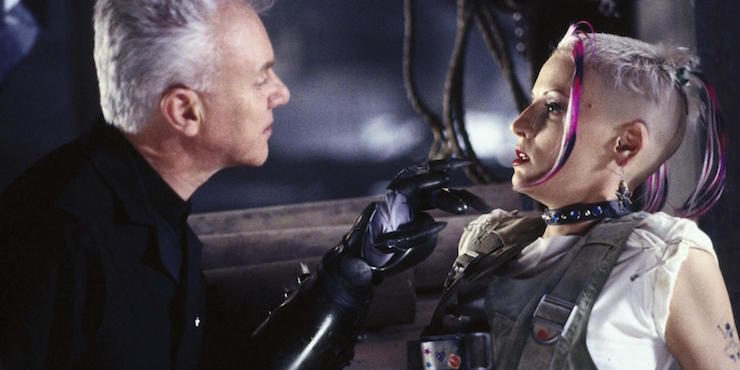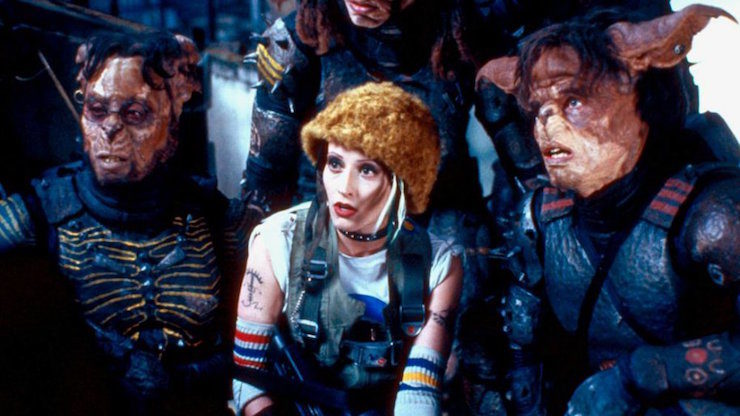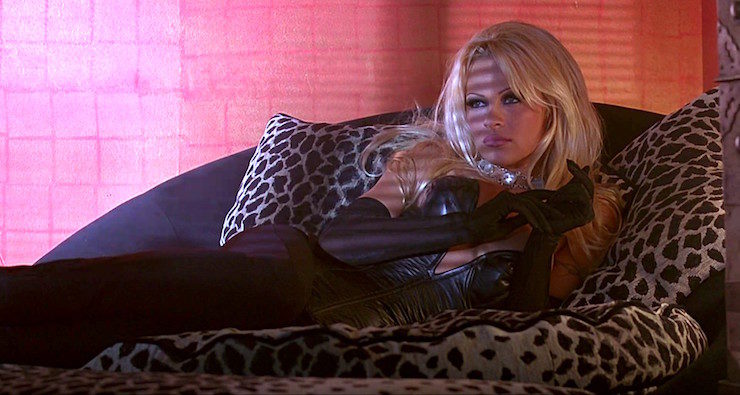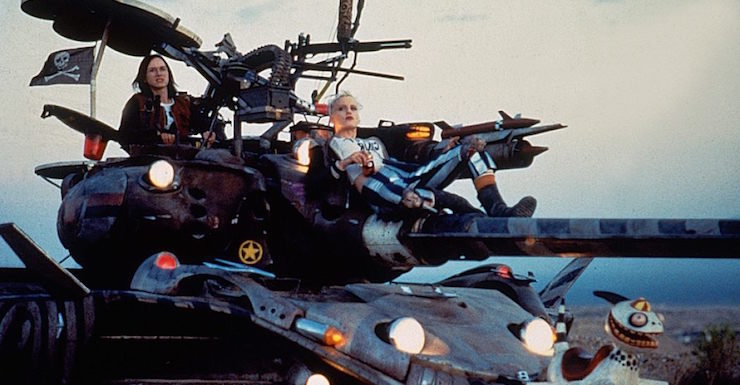The 1990s was the era of the “bad girl” in comics, with such characters as Shi, Witchblade, Razor, the women of Gen13, and more. Two of the earliest and most successful examples were Tank Girl, which started in a UK comic magazine called Deadline, and which was more of an underground comic tying into the punk scene of the era; and Barb Wire, a dystopian future series from Dark Horse.
Both got made into mid-1990s movies that did remarkably poorly at the box office.
Barb Wire is one of many films produced by Dark Horse Entertainment, an arm of the comics company designed specifically to produce film and TV versions of their funnybooks. Barb Wire was their fourth film (following The Mask, which we’ll cover next week, along with Dr. Giggles and Timecop), and their first big flop. Intended as a starring vehicle for Pamela Anderson (then going by her married name of Pamela Anderson Lee), whose star was rising following her runs on Home Improvement and Baywatch, it failed rather spectacularly at that, as the movie tanked with both critics and viewers. On top of that, it received multiple Golden Raspberry Awards, with Anderson winning a Razzie for Worst New Star (she was also nominated for Worst Actress, though she “lost” to Demi Moore, whose Striptease “beat” Barb Wire for Worst Picture).
Tank Girl had similar issues finding its audience, though it at least has managed to gain a cult following in the years since its release. Director Rachel Talalay got the rights to the comic after being given a copy by her step-daughter. She had trouble finding a studio, and when MGM agreed, they wound up making tons of changes and alterations based on focus groups and an unwillingness to fully embrace the sleazier aspects of the storyline. (As just one example, an early scene was re-shot to remove Tank Girl’s dildo collection.) Talalay and comics creators Jamie Hewlett and Alan Martin were all displeased with how the final product came out. Hewlett and Martin even had to create several animated and comic panels to flesh out scenes that were either never shot or shot poorly, and they made several changes to the script that were ignored.
“I don’t know how you do things in Washington, Colonel, but I do make the occasional arrest without slaughter.”

Barb Wire
Written by Ilene Chaiken and Chuck Pfarrer
Directed by David Hogan
Produced by Todd Moyer and Mike Richardson and Brad Wyman
Original release date: May 3, 1996
The year is 2017. (No, really, that’s the year this movie takes place in!) As the Second American Civil War rages on, with the fascistic Congressional Directorate coming out mostly ahead, the only free city in what used to be the United States is Steel Harbor. Barbara Kopetski, who now goes by “Barb Wire,” is the newest dancer at a strip club. (One audience member calls her “babe,” which she hates so much that she throws her shoe at him, the spike heel impaling his head. The crowd thinks that’s just an awesome addition to the act.)
Turns out her strip act is a cover. She’s been hired to retrieve a girl who was kidnapped by the club’s owner. She frees the girl and returns her to her parents for payment—though they don’t have the full amount they agreed on, so Barb takes their car.
She returns to the bar she owns, the Hammerhead. Even with the rescue job, she can’t quite make payroll, so she does a bounty hunter job, again posing as a sex worker, this time a prostitute. She gets a john who lives next door to a guy who skipped out on bail—said john allows her ingress to the apartment building, which is only possible via retinal scan of a resident.
The john is into bondage, and she uses the paddle to knock him unconscious rather than spank him, then blows the wall between his place and that of Krebs, her target. However, to her surprise, Krebs has protection: two Steel Harbor cops, moonlighting for Schmitz, the bail bondsman. Barb kills them both and delivers Krebs to Schmitz.
But it turns out that Krebs didn’t skip bail. In a world where everyone is identified by retinal scan, Krebs has in his possession special contact lenses that will get anyone through any such scan.
Krebs has made a deal with Axel Hood, a former resistance fighter, and former lover of Barb’s. Hood and Barb fought against the Directorate in the past, along with Barb’s brother Charley. Charley was blinded by a grenade and now he spends all his time at the Hammerhead drinking.
Hood is transporting Dr. Corrinna Devonshire, a.k.a. “Cora D,” through Steel Harbor with the intent of getting her to Canada. She has in her DNA the cure to a nasty disease that the Directorate is going to use to wipe out any population that doesn’t submit to their rule. Hood and Devonshire are married. With Krebs captured, Hood goes to Barb, but she no longer takes sides, and won’t help them.
The Directorate has sent Colonel Pryzer to find Devonshire and bring her back alive. Working with the chief of Steel Harbor Police—the very corrupt Alexander Willis—Pryzer finds Krebs’s body. Both his eyes and the contacts have been removed.
It turns out that Schmitz has them. He tries to get Barb to broker a deal, but she’s not interested. However, he hides the contacts in her kitchen and runs away. Pryzer coerces Willis into getting a warrant to search Hammerhead. Of course, Pryzer’s soldiers’ notion of “searching” is to smash and shoot up the place, which probably would have destroyed the lenses, but whatever.
Barb brokers a deal with “Big Fatso,” the local crime boss. He’ll guarantee her and Charley safe passage to the airport in exchange for the lenses and a ton of cash. Her plan is to go to Europe, where Charley can get his eyes reconstructed.
However, Pryzer has tortured and killed the local resistance cell as well as Charley, and strung them up. Furious, Barb changes plans, and takes Hood and Devonshire with her to meet Big Fatso. However, the crime boss has double-crossed her, and Pryzer arrives with Willis.
While pretending to handcuff Barb, Willis hands her a grenade, which enables her to cause enough of a distraction for her, Hood, Devonshire, and Willis to drive through the unoccupied zone toward the airport. Pryzer and his troops give chase, but eventually our heroes are triumphant as Pryzer’s troops are killed and the colonel himself is blown up. Barb gives Devonshire the lenses (the ones she gave to Big Fatso were ordinary lenses; she had the real ones in her own eyes) so she can fly to Québec with Hood, and Barb still has the money from Big Fatso, so she can fly wherever she wants. As she goes off, Willis says that he thinks he’s in love, which is a much crummier closing line than, “This is the beginning of a beautiful friendship.”
“Look, it’s been swell, but the swelling’s gone down.”

Tank Girl
Written by Tedi Sarafian
Directed by Rachel Talalay
Produced by Pen Densham and Richard Barton Lewis and John Watson
Original release date: March 31, 1995
It’s the year 2033, and a comet struck the Earth. It hasn’t rained since, and water has become a valued commodity. Rebecca Buck is part of an underground that siphons their own water illegally—all water is controlled by the prosaically named Water and Power Company, run by Kesslee.
Rebecca is a little crazy and somewhat freewheeling. When W&P shows up at the commune where she lives, she’s one of only two survivors. Both she and Sam, one of the girls, are taken prisoner. Everyone else, including her lover and her buffalo, are shot and killed.
Continuing to rebel, Kesslee views Rebecca as a project, someone it will be fun to break. He never even comes close, despite straitjackets, imprisoning her in a tiny tube, and more. She tries to escape, with the help of a technician named Jet Girl, but they fail. Kesslee uses Rebecca as a stalking horse to find the sub-gates that lead to the hideout of the Rippers—genetically modified soldiers from a previous war that have been left on their own. Rippers have ravaged the area, working against W&P, and Kesslee wants them destroyed.
However, just as they’re about to send Rebecca out to find the sub-gates, the Rippers attack, leaving Kesslee maimed (his face is all but destroyed, and his left arm is cut off) and enabling Rebecca and Jet to escape in a tank and a flyer.
They run away across the desert, coming across Sub Girl, who helps them refurbish their vehicles to make them look more funky (and less like they come from W&P). Rebecca—or Tank Girl, as she prefers to now be called—finds out that Sam is alive and is employed at Liquid Silver, a sex club.
Kesslee, who is in the process of receiving a lethal prosthetic arm and a holographic new head, sets a trap for Tank Girl and Jet at Liquid Silver, but it doesn’t quite spring according to plan, as the two women get away—after Tank Girl forces the Madam to sing Cole Porter’s “Let’s Do It.” Kesslee is able to take Sam prisoner, though.
Determined to get Sam back, Tank Girl needs an army, so she decides to recruit the Rippers. She and Jet do exactly what Kesslee had wanted her to do, and they find a Ripper hideout. The Rippers themselves—a product of splicing human and kangaroo DNA—are not particularly welcoming at first, but are willing to give them a chance to prove their loyalty. They’ve received word of a shipment of weapons to W&P, and they want Tank and Jet to get it for them.
The women succeed, but the shipment isn’t weapons—it’s the body of the Rippers’ leader, Johnny Prophet, whom they had thought was on walkabout. Furious, the Rippers, Tank, and Jet attack W&P’s headquarters, but they find out that Kesslee has been one step ahead of them all along. He had placed subcutaneous microphones in Tank so he listened in on everything she said and heard.
However, the Rippers manage to take care of most of Kesslee’s troops, and Tank Girl takes out Kesslee himself, stabbing him with the same multiblade device that dehydrates a person that he’s used on several of his underlings. The Rippers and Tank Girl and Jet Girl all have control of the water now.
“All in favor of crumpets and tea, say ‘Aye’!”

Okay, first of all, I’d totally forgotten that Talalay, who has rapidly become one of the finer directors of genre TV shows (in the last year alone, she has directed episodes of Doctor Who, The Flash, Legends of Tomorrow, Riverdale, Sherlock, and Supergirl) directed Tank Girl.
And she did a decent job, mostly by the perfect casting of Lori Petty in the title role. Petty was pretty much born to play Hewlett and Martin’s anarchic character. The movie is a delight to watch, simply because Petty is just having so much fun in the role. Tank Girl is who we all wish we could be, constantly laughing in the face of danger and refusing to give in to the bad guys and always coming out ahead, mostly by virtue of having absolutely no fucks to give.
It’s only a pity the plot is so incredibly terrible. Coherent plotting isn’t really one of Tank Girl’s strong suits in four-color or 35-millimeter form, but so many things in this movie just happen because it’s the next thing without rhyme or reason. And that level of craziness can work if you actually embrace it, but the movie never really goes all the way in diving feet-first into the insanity. (From all reports, Talalay wanted to, but was restrained by MGM.)
On top of that, the original comic has a very Anglo-Australian sensibility, which is completely missing from this interpretation. (It doesn’t help that the only Brits in the cast are Malcolm McDowell and Naomi Watts.)
Barb Wire also has plot issues, but they’re much simpler and more fundamental: the story is basically a dystopian science fiction version of Casablanca, with many of the genders reversed.

Here’s the thing—there are several reasons why Casablanca is a classic and considered one of the great movies of all time, but none of those reasons are the plot. The actual story of Casablanca is kinda dumb. What makes it work, though, are the performances, the romance, and most especially some of the finest dialogue in any film ever.
None of those elements are present in Barb Wire. The script is pedestrian, the romance is nonexistent (there’s plenty of lust in this movie, but Anderson and Temuera Morrison have absolutely no chemistry), and the performances are almost uniformly terrible. The only actor who shows up for work, as it were, is the always-reliable Xander Berkeley as Willis. Just as Claude Rains almost stole the show in Casablanca with his gleefully corrupt Inspector Renault, Berkeley completely steals the show as the similarly corrupt Willis, only this time it’s by process of elimination, as there’s nobody else in this movie who can actually act.
Well, okay, Steve Railsback can act—he plays Pryzer—but he doesn’t bother to do so. The climax when Pryzer, after being controlled and calm the entire movie, suddenly starts cackling like a loon in his final confrontation with Barb may be the most embarrassing moment of Railsback’s career (and I say this acknowledging that he starred in Lifeforce). And Anderson can, too, but her talents are much better suited to comedy (as an example, she was excellent in the series V.I.P., where she was pretty much playing a version of herself for laughs, but it worked). Here, she’s called upon to be an embittered antihero, and it’s a bad fit. There’s also a flashback to her as a soldier, which is even more laughable than her attempt to be an action hero.
Tank Girl fares much better in the performance part, at least, but that’s because Talalay decided to use good actors in her film. The presence of a supporting cast that includes Ice-T, Reg E. Cathey, Jeff Kober, and James Hong, as well as Watts and McDowell, can cover a multitude of sins.
These are both dystopian SF movies based on independent comics of the late 1980s/early 1990s, and both are deeply flawed, but the only one actually worth watching is Tank Girl, as there’s something to leaven the flaws—Petty’s performance, mostly. In Barb Wire, there’s really nothing, unless you want to see a great deal of Anderson’s cleavage. (Honestly, Anderson’s breast implants are prominent enough in this movie that they should’ve gotten separate billing.) Both are written as strong feminist stories, but the fetishizing of Anderson’s body and the general terrible-ness of Barb Wire kinda ruins that. Tank Girl succeeds much more admirably, especially in the sis-mance between Tank and Jet.
Next week, as indicated above, we’ll look at one of Dark Horse’s successes, The Mask, as well as its less-successful sequel Son of the Mask. (I know I said last time I’d do Judge Dredd with Barb Wire, but this is a better fit. We’ll look at both Judge Dredd with Sylvester Stallone and the more recent Dredd with Karl Urban in two weeks.)
Keith R.A. DeCandido knows how much wood a woodchuck would chuck if a woodchuck could chuck wood.










